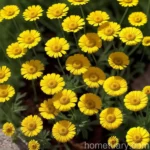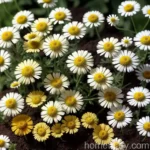Golden Marguerite (Anthemis tinctoria ‘Moonlight’)
In the world of gardening, the golden marguerite (Anthemis tinctoria ‘Moonlight’) stands out as an attractive and versatile perennial plant. With its delicate foliage and cheerful yellow flowers, this plant adds a touch of brightness to any garden or landscape. Its ease of care and multiple uses make it a popular choice among gardeners. In this comprehensive guide, we will explore everything you need to know about the golden marguerite, from its cultural requirements to its propagation and common pests and diseases.
What is the Golden Marguerite (Anthemis tinctoria ‘Moonlight’)?
Golden marguerite, scientifically known as Anthemis tinctoria ‘Moonlight’, is a herbaceous perennial belonging to the Asteraceae family. This plant is native to Europe, where it is found in grasslands, meadows, and open woodland areas. It is widely cultivated for its ornamental value and is favored for its ability to attract pollinators such as bees and butterflies.
The ‘Moonlight’ variety of Anthemis tinctoria is particularly sought after for its soft, fern-like foliage and profuse, daisy-like golden-yellow flowers. The plant typically grows to a height of 18 to 24 inches (45 to 60 cm) and spreads to about 24 to 36 inches (60 to 90 cm). It blooms from late spring to midsummer, adding a burst of color to the garden.
Key Takeaways – Golden Marguerite (Anthemis tinctoria ‘Moonlight’)
Before delving into the specifics of caring for the golden marguerite, here are some key takeaways about this delightful plant:
- Culture: Easy to grow and low maintenance
- Uses: Ornamental, attracts pollinators
- Water: Moderate watering needs
- Sunlight: Thrives in full sun
- Fertilizer: Minimal fertilizer requirements
- Soil: Well-draining, average fertility
- Pruning: Deadheading for prolonged blooming
- Propagation: Division, seeds
- Container: Suitable for container gardening
- Popularity: Widely cultivated in gardens
- Common Diseases: Powdery mildew
- Common Pests: Aphids, spider mites
- Botanist’s Tips: Use as a companion plant, cut flower
Now, let’s explore each of these aspects in detail to understand how to care for the golden marguerite and help it thrive in various garden settings.
Culture
Uses
The golden marguerite is primarily cultivated for its ornamental value. Its bright yellow flowers and finely textured foliage make it a charming addition to flower borders, rock gardens, and cottage-style landscapes. Due to its attractiveness to pollinators, it is often used in wildlife gardens to support and attract bees, butterflies, and other beneficial insects.
Water
When it comes to watering, the golden marguerite prefers moderate moisture levels. It thrives in well-draining soil and should be watered regularly, especially during periods of drought. However, it is essential to avoid overwatering, as soggy or waterlogged soil can lead to root rot and other issues. A layer of mulch around the base of the plant can help retain soil moisture and regulate the temperature of the roots.
Sunlight
One of the key requirements for the golden marguerite is ample sunlight. This plant thrives in full sun, meaning it requires at least six hours of direct sunlight each day to reach its full potential. In regions with extremely hot summers, some afternoon shade may be beneficial to prevent the plant from wilting. However, overall, a sunny location is essential for robust growth and prolific blooming.
Fertilizer
In terms of fertilizer needs, the golden marguerite is relatively low maintenance. It typically grows well in average soil fertility and does not require heavy feeding. However, incorporating a balanced, slow-release fertilizer into the soil during the plant’s active growth phase can provide the additional nutrients needed for healthy foliage and abundant flowering. It is crucial to follow the recommended application rates to avoid over-fertilization, which can lead to excessive foliage growth at the expense of flowers.
Soil
Golden marguerite thrives in well-draining soil with average fertility. It can adapt to various soil types, including sandy, loamy, or clayey soils, as long as they do not become waterlogged. Prior to planting, amending the soil with organic matter, such as compost or well-rotted manure, can improve its structure and fertility. This allows for better aeration and moisture retention, creating an optimal environment for the plant’s roots to establish and flourish.
Pruning
To promote prolonged blooming and maintain the plant’s appearance, regular deadheading is recommended. Removing spent flowers not only encourages the production of new blooms but also prevents the plant from diverting energy into seed production. Additionally, deadheading helps prevent self-seeding, which can be beneficial in preventing the plant from becoming invasive in certain settings.
Propagation
Golden marguerite can be propagated through division and seeds. Dividing mature clumps in early spring or fall allows for the creation of new plants and also helps rejuvenate older specimens. When dividing, it is essential to ensure that each division has a healthy portion of roots and shoots to support its growth.
As for seed propagation, collecting seeds from mature flowers and sowing them in a well-prepared seedbed can yield new plants. Sowing seeds directly in the garden in late spring or early summer can also lead to successful germination and establishment. It is important to keep the seedbed consistently moist until the seedlings are well established.
Container Popularity
The golden marguerite is well-suited for container gardening, making it a versatile choice for those with limited garden space. When grown in containers, it can be placed on patios, balconies, or outdoor living areas to add a splash of color and texture. Selecting a container with adequate drainage holes and using a well-draining potting mix is essential for the plant’s overall health and growth. Container-grown golden marguerite may require more frequent watering due to faster moisture evaporation from the potting mix.
Common Diseases
Disease Diagnosis
One of the common diseases that the golden marguerite may encounter is powdery mildew. Powdery mildew appears as a white, powdery substance on the foliage, often leading to a decline in plant health and aesthetics. It is crucial to monitor the plant closely and take preventive measures to minimize the risk of powdery mildew. Providing adequate air circulation, spacing plants properly, and avoiding overhead watering can help mitigate the likelihood of powdery mildew development.
Common Pests
Despite being a relatively low-maintenance plant, the golden marguerite is susceptible to certain pests such as aphids and spider mites. These pests can cause damage to the foliage and flower buds, impacting the overall health and appearance of the plant. Regularly inspecting the plant for signs of pest infestations and taking timely action, such as using insecticidal soap or introducing natural predators, can help control pest populations and protect the plant.
Botanist’s Tips
Fun Facts
- The golden marguerite is known for its attractiveness to pollinators, particularly bees and butterflies, making it a valuable addition to wildlife or pollinator gardens.
- The plant’s finely dissected foliage gives it an airy and delicate appearance, adding textural interest to garden beds and borders.
- Golden marguerite is often used in traditional herbal medicine for its purported medicinal properties, though it is essential to consult a healthcare professional before using it for medicinal purposes.
Links to External Resources
For further information on Anthemis tinctoria ‘Moonlight’ and related topics, refer to the following resources:
- Royal Horticultural Society – Anthemis tinctoria ‘Moonlight’
- The Plant Encyclopedia – Golden Marguerite
In conclusion, the golden marguerite (Anthemis tinctoria ‘Moonlight’) is a delightful perennial plant that offers a wealth of benefits to gardeners and nature enthusiasts. With its cheerful flowers, fine foliage, and multiple uses, it is a valuable addition to any garden or landscape. By understanding and meeting its cultural requirements, we can ensure that this charming plant thrives and continues to brighten our outdoor spaces for years to come.















